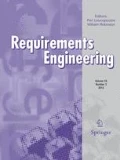Abstract
This viewpoint argues that the introduction of most computer-based system to an organization transforms the organization and changes the work patterns of the system’s users in the organization. These changes interact with the users’ values and beliefs and trigger emotional responses which are sometimes directed against the software system and its proponents. A requirements engineer must be aware of these emotions.
Notes
This quotation is from a draft that preceded publication as a chapter in a book [15]. The quotation did not survive into the book chapter. However, by e-mailed personal communication, Joseph Goguen assures us that he still believes in the contents of the quotation and that he does not disown it.
References
Ramos I, Berry DM, Carvalho JA (2005) Requirements engineering for organizational transformation. J Inform Softw Technol 47(5):479–495
Lehman MM (1980) Programs, life cycles, and laws of software evolution. Proc IEEE 68(9):1060–1076
Esteves J, Pastor J (2001) Enterprise resource planning systems research: an annotated bibliography. Commun Assoc Inform Syst 7(8):1–51
Dickson GW, DeSanctis G (2000) Information technology and the future enterprise: new models for managers. Prentice-Hall, Englewood Cliffs
Palmer I, Hardy C (2000) Thinking about management. Thousand Oaks, Sage
Bergman MB, King JL, Lyytinen K (2002) Large-scale requirements analysis revisited: the need for understanding the political ecology of requirements engineering. Requirements Eng J 7(3):152–171
Damásio A (1999) The feeling of what happens: body and emotion in the making of consciousness. New York, Harcourt Brace
Parker S, Wall T (1998) Job and work design: organizing work to promote well-being and effectiveness. Thousand Oaks, Sage
Snizek WE (1995) Virtual offices: some neglected considerations. Commun ACM 38(9):15–17
Markus ML (1983) Power, politics and MIS implementation. Commun ACM 26:430–444
Huff C (2002) Gender, software design, and occupational equity. Inroads, SIGCSE Bull 34(2):112–115
Boehm BW, Ross R (1989) Theory W software project management: principles and examples. IEEE Trans Softw Eng SE 15(7):902–916
Boehm B, Bose P, Horowitz E, Lee MJ (1994) Software requirements as negotiated win conditions. In: Proceedings of the first international conference on requirements engineering (ICRE94) IEEE Computer Society, Colorado Springs, CO, pp 74–83
Goguen JA (1993) Requirements engineering as the reconciliation of technical and social issues. Technical Report, Centre for Requirements and Foundations, Programming Research Group, Oxford University Computing Lab, modified version later published as 15, Oxford, UK
Goguen JA (1994) Requirements engineering as the reconciliation of technical and social issues. In: Goguen JA, Jirotka M (eds) Academic Press, London, pp 165–199
Ramos IMP (2000) Aplicações das Tecnologias de Informaçãoque Suportam as Dimensões Estrutural, Social, Política e Simbólica do Trabalho. PhD Dissertation, Departamento de Informática, Universidade do Minho Guimarães, Portugal
Santos I, Carvalho JA (1998) Computer-based systems that support the structural, social, political and symbolic dimensions of work. Requirements Eng J 3(2):138–142
Easterbrook SM (1992) SCW: co-operation or conflict? Springer, London
Krumbholz M, Galliers J, Coulianos N, Maiden NAM (2000) Implementing enterprise resource planning packages in different corporate and national cultures. J Inform Technol 15:267–279
Krumbholz M, Maiden NAM (2000) The implementing of ERP packages in different organisational and national cultures. Inform Syst J 26(3):185–204
Pfeffer J, Salancik G (1978) The external control of organizations: a resource dependence perspective. Harper & Row, New York
Sickenius de Souza C, Prates RO, Barbosa SDJ (2003) Adopting information technology as a first step in design, lessons learned from working with Brazilian social volunteers. Interactions X(2):72–79
Boehm BW, Huang LG (2003) Value-based software engineering: a case study. IEEE Computer 36(3):33–41
Rost J (2004) Political reasons for failed software projects. IEEE Software 21(6):104, 102–103
Boehm BW (1981) Software engineering economics. Prentice-Hall, Englewood Cliffs
Lutz RR, Mikulski IC (2004) Empirical analysis of safety-critical anomalies during operations. IEEE Trans Softw Eng SE 30(3):172–180
Acknowledgements
We thank the anonymous referees of our previous papers for their helpful comments. Daniel Berry’s work was supported in part by a Canadian NSERC grant, NSERC-RGPIN227055-00.
Author information
Authors and Affiliations
Corresponding author
Rights and permissions
About this article
Cite this article
Ramos, I., Berry, D.M. Is emotion relevant to requirements engineering?. Requirements Eng 10, 238–242 (2005). https://doi.org/10.1007/s00766-005-0014-5
Received:
Accepted:
Published:
Issue Date:
DOI: https://doi.org/10.1007/s00766-005-0014-5

